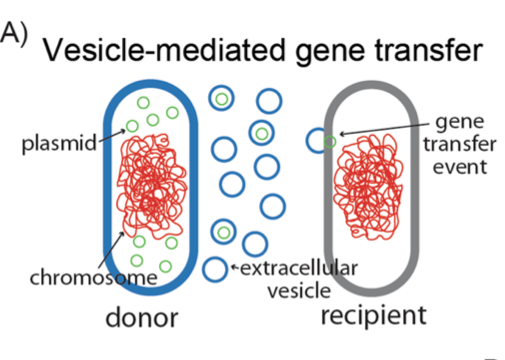Unlike animals, bacteria can readily share genetic information with other bacteria, even those of entirely different species. Because of this, one clever microbiologist likened bacteria to smartphones and genes to apps. When bacteria share "apps" that encode antibiotic resistance, it poses trouble for humanity.
As individual bacterial strains are exposed to antibiotics, natural selection favors the survival of those that have mutated to become resistant. That hard-earned resistance can then be given to other bacteria. Microbiologists have long known of three major mechanisms by which this occurs: Transformation, transduction, and conjugation.
Transformation occurs when a bacterium dies and sheds its DNA into the environment. Some bacteria are capable of snatching it up and incorporating it into their own DNA. This process was discovered nearly 90 years ago when harmless bacteria were mixed with dead, but lethal, bacteria and injected into mice. The mice died. It was eventually ascertained that the harmless, living bacteria took up the DNA from the dead, lethal bacteria and were transformed into lethal, mouse-killing microbes.
Transduction is a biological mistake. When bacteria-specific viruses, known as (bacterio)phage, infect bacteria, their primary intent is to hijack the cell, create thousands of copies of themselves, and then blow up the cell, spreading more viruses into the environment. Viral replication is sloppy, so some viral particles accidentally package bacterial DNA inside of them. When this defective virus tries to infect another bacterium, it simply injects it with DNA from its previous host. The bacterium lives, and if it's lucky, it might have been injected with useful genes, which it can then incorporate into its chromosome.
Conjugation is the closest thing bacteria have to "sex." During conjugation, one bacterium latches on to another and inserts DNA directly into it.
For decades, these mechanisms for spreading DNA from one bacterium to another -- known as horizontal gene transfer -- were the only three known. Now, researchers Frances Tran and James Boedicker of the University of Southern California believe they have characterized a fourth. Their results are published in Scientific Reports.
Extracellular Vesicles: A Fourth Mechanism of Bacterial Gene Transfer?
 Bacteria are known to shed bits of their membranes (known as "blebbing") in a process that resembles a lava lamp. (See upper left image.) The blobs that blossom and break off from the cell may contain all sorts of molecules, such as proteins and DNA. Other bacteria can absorb them. This observation led several different research groups to hypothesize that extracellular vesicles may serve as a previously unidentified mechanism of gene transfer.
Bacteria are known to shed bits of their membranes (known as "blebbing") in a process that resembles a lava lamp. (See upper left image.) The blobs that blossom and break off from the cell may contain all sorts of molecules, such as proteins and DNA. Other bacteria can absorb them. This observation led several different research groups to hypothesize that extracellular vesicles may serve as a previously unidentified mechanism of gene transfer.
Dr. Tran and Dr. Boedicker further characterized this enigmatic process. In one key experiment, they showed that extracellular vesicles loaded with DNA encoding antibiotic resistance and produced by three different species of bacteria could be transferred to other, unrelated species of bacteria. Disturbingly, there was no correlation between the rate of DNA transfer and the relatedness of the bacteria. In other words, it's just as likely that a bacterium would share antibiotic resistance with a complete microbial stranger as with a close cousin.
These findings are slightly unsettling. Unlike transformation, transduction, and conjugation, gene transfer via extracellular vesicles may not require specialized machinery. And because membrane blebbing is thought to occur in most -- if not all -- bacteria, extracellular vesicles may represent a universal method of bacterial gene transfer. That could mean that antibiotic resistance may spread to unrelated bacteria much easier than microbiologists previously imagined.
That's good for nobody, except for perhaps microbiology textbook authors who will now need to release new, updated editions.




